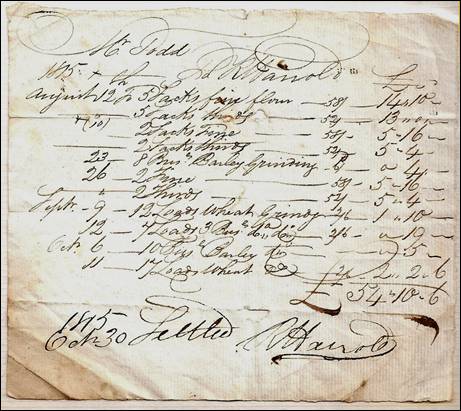Preface
This article provides comments on the Second Earl of Dartmouth (mid 18th century) and his estates, from where the house presumably obtained its name, and on the possible origins and development of the house. Scans are included as examples of the well preserved receipts, discovered under the floorboards by former owners Mr and Mrs Hargreaves, which provide snapshots of Olney society at the turn of the nineteenth century. Finally, a few words are added on Edgar Mobbs, the legendary soldier sportsman, who resided in Dartmouth House at the turn of the 20th century.
(More on Edgar Mobbs can be found on a separate web page.)
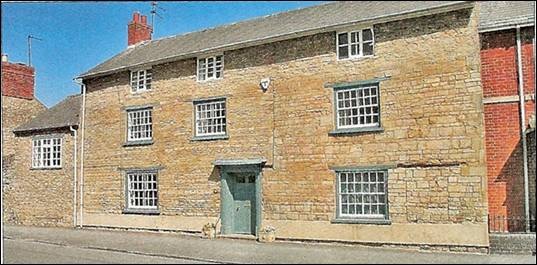
Relatively recent photograph of Dartmouth House
The article should be considered only as an introduction to Dartmouth House, since there are doubtless many other interesting facets and stories to be unearthed and recounted.
Dartmouth House is currently owned by Stewart and Shirley Elsmore and is available for lease as a holiday cottage.
Dartmouth House
Dartmouth House, situated on Dartmouth Road Olney, is an imposing double fronted stone building on three floors with an adjoining two storey annex. Its origins can be traced to the Second Earl of Dartmouth through the Enclosure Act of 1767. The section of the Act relating to Olney states that ‘William, Earl of Dartmouth, in his own right, and in right of Frances Katherine, Countess of Dartmouth his wife, is Lord of the Manor of Olney and Warmington, otherwise Warrington, in the said Parish’. William, the Second Earl of Dartmouth, had inherited the estate through his marriage in January 1755 to the Olney heiress, Frances Katherine Nichol. In 1796 he commissioned a survey of Olney from which the earliest known map of Olney formed part.
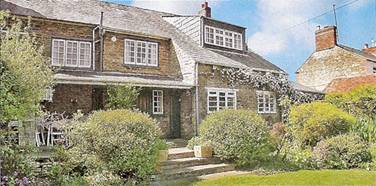
Relatively rcent photograph of Dartmouth House – rear view
The survey, undertaken by Thomas Bainbridge of Gray’s Inn, describes the building now known as Dartmouth House as a ‘Farm House and Homestead’. It replaced the original farmhouse which was situated on the opposite side of the road in the centre of the former churchyard. The statement in the survey dates the property at more than two hundred years old. The entire estate consisted of 129 acres and included the Weston Meadow, the land known as Christian Well Close, now containing the development of Colson’s Way, Mow Meade, Ferne Furlong, Kippel Hill and Lilly Hill. It also includes fields lying alongside Yardley Road and near Olney Park. There is no evidence to suggest that there was ever a direct connection between any Earl of Dartmouth and Dartmouth House.
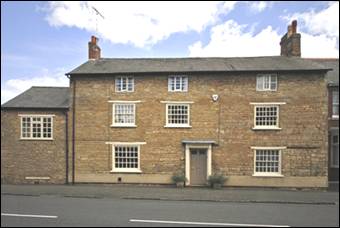
Another recent photograph of Dartmouth House
Dartmouth House shows evidence of alterations having been made at various periods. For example, there is external evidence of a filled-in doorway, different workmanship in the stonework, and the different level of the annex window to the house windows. Local stone was used either from the former Olney quarries along Warrington Road, from Long Lane, or from Weston Underwood. There is plenty of limestone locally as Olney is situated on the Jurassic Ridge, which runs in a wide band from Lincolnshire to the Dorset Coast.
To the left of the front door is the lounge, and to the right, the dining room. The lounge has a deep window overlooking the street. The chimney breast forms the wall to the north and a former doorway to the right of the fireplace led down into the barrel vaulted cellar underneath the adjoining annex. The original steps down from the doorway in the lounge can still be seen. Behind the lounge is the kitchen which extends into the garden. The dog-leg-staircase at the end of the hallway is likely to be a replacement for the stairs which went up from the lounge, and the hallway was almost certainly a straight passageway through to the original back door.
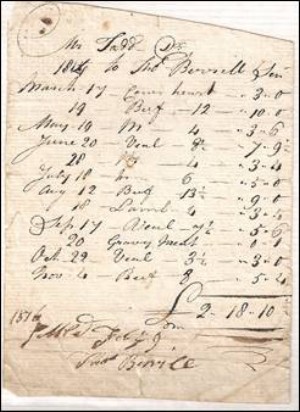
Thomas Berrill – meat bill
Well preserved receipts were found under the floorboards by former owners, Mr and Mrs Hargreaves, during a restoration of Dartmouth House. These receipts throw light on aspects of Olney society during the late eighteenth and early nineteenth centuries. In particular, they record outgoings by the first tenant Thomas Whitmee. They also show that Joseph Todd had a close association with the property and it is possible that he lived there as the house may have been sub-divided at that time.
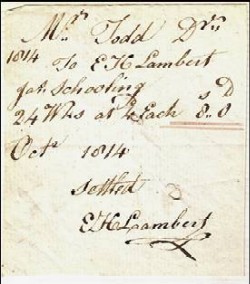
E H Lambert – schooling bill
Thomas Whitmee was an Overseer of the Poor. His acquisition of wool, ‘papers of pins’, thread and ‘gymp’ for lace making, was known to be a Workhouse activity. In his dealings with the upkeep of the poor in the parish he recorded the names of some contemporary tradesmen and craftsmen. In 1814 examples are: local barber William Wilson; butchers R Chater, T Berrill and George Knight, master mason Robert Clifton and glazier Michael Hind. Two medical men, T Biggs and George Grindon who attended the inmates of the workhouse are also recorded. Finedon and Cobb were carpenters who provided shrouds and coffins for the poor.
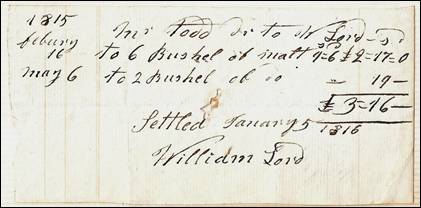
William Lord – malt bill
The Whitmee and the Todd families were united by the marriage of their children, Thomas Whitmee’s son, Samuel to Mary Ann Todd, Joseph’s daughter. It is known that Joseph Todd was a baker who probably had his bake-house in the outbuildings down the southern side of the property. As in Whitmee’s case, bills record the local business men who were his associates. He regularly paid William Pebody, a blacksmith, for tyres, shoes and nails, so presumably he had a delivery cart and horse. William Lord and Robert York provided him with malt and hops for brewing; flour for bread-making came regularly from Richard Harrold at Olney Mill and also from the millers at Lavendon and Ravenstone. Salt was supplied by J H Talbot and Samuel Davison, both with premises on the Market Place.
The cost of contemporary education is recorded in bills originating in Mr Haddon’s school (held in what is now The Old Manse in the High Street), which was attended by John Todd, Joseph’s eldest son. Here the cost was £1. 0. 2d a quarter, and E H Lambert’s school attended by James Todd cost his father 8s. 0d for 24 weeks. A daughter went to Catherine Sample’s school, and later to Mesdames Gleadah and Mabley on the south side of the Market Place where the cost was one guinea for half a year’s tuition with one shilling for ‘firing’. Another bill shows Thomas Whitmee’s purchase of a shirt from Hannah Smith, a draper. Hannah was a Quaker and it is interesting to note that the bill is dated ‘3 month’ the Quaker way of writing March. Hannah is the mother of Ann Hopkins Smith, the Quaker who sponsored the building of the Almshouses in Weston Road in 1819. (A charitable trust to maintain the upkeep of these Almshouses still survives.)
Joseph Todd was likely to have been a successful businessman as the sum he was prepared to pay for his wearing apparel shows. This included ‘a fine flannel waistcoat faced with silk’ and ‘a pair of fine velveteen breeches’. His ‘great coat with trimming of beaver and velvet’ sounds very smart.
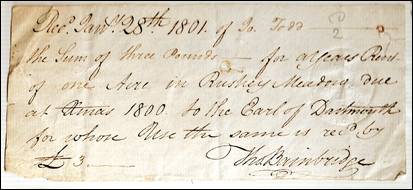
Thomas Bainbridge for rent of meadow
A particularly interesting find was the Constables Account (shown below) with a description of people needing lodging from 25th October to 13th March (no year given). These people are probably mostly travellers passing through the town who were lodged at the various inns.
Dartmouth House has seen several owners over the last two hundred years. These include the Mobbs, the Grindons, the Arnolds, the Hargreaves and currently, Stewart and Shirley Elsmore. Edgar Roberts Mobbs was a particularly noted resident of Dartmouth House during the early twentieth century.
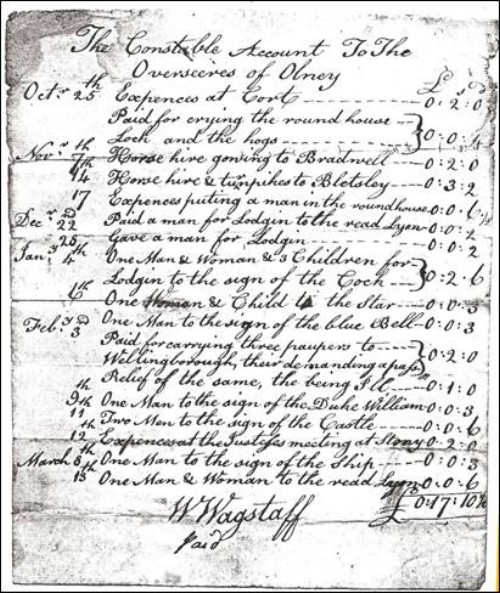
The Constable Account to the Overseers of Olney
Edgar, born 1882, was a gifted rugby union footballer who played for and captained Northampton RFC (the Saints) and later the England team in 1910. Dartmouth House was the family home of Edgar’s parents during the early 1900s. Subsequently Edgar was equally renowned for his memorable military career in the Northamptonshire Regiment during the First World War. Soon after being promoted to Lieutenant Colonel he was killed in action in 1917 whilst leading a charge at Passchendaele. Later he was acknowledged as a distinguished hero of the First World War; the monument to his memory in Abington Square, Northampton being a testimonial of his heroic exploits.
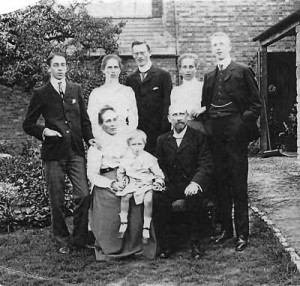
The Mobbs family in the garden of Dartmouth House
Edgar is on the right wearing a watch chain
(More on Edgar Mobbs can be found on a separate web page.)
Acknowledgements
The Society is indebted to Elizabeth Knight for her permission to use her research on Dartmouth House, dated December 2000, as the basis for this article; also to Stewart and Shirley Elsmore for their permission to use the well preserved receipts found under the floorboards of Dartmouth House by former owners, Eric and Sheila Hargreaves. Grateful thanks also to Phil Mobbs for permission to use the family photograph.
.
Copyright © 2008 Olney & District Historical Society

